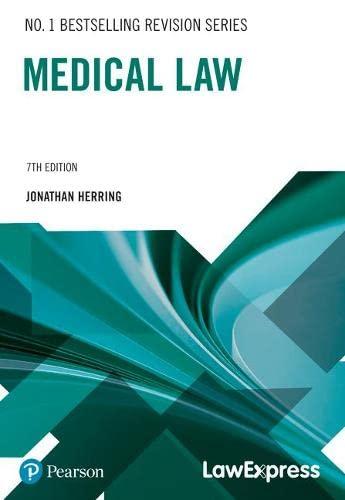Question
Analyze each of these three cases in your mind and then state the legal issues to be considered. 2. Evaluate the legal issues in this
Analyze each of these three cases in your mind and then state the legal issues to be considered.
2. Evaluate the legal issues in this case and determine the strengths and weaknesses of (a.) the suit by the Plaintiff against the defendant. List the strengths and weaknesses you identify.
3. Deduce logical and specific arguments based on the information you have learned in the Chapters we have covered for this test of your textbook and what you have learned in this course. (I am looking for verifiable deductions from the material we have covered and not just your opinion).You also must cite the source which is the basis for your deduction such as the cases or the writings that are similar which we have covered.You may also seek and cite outsource reputable sources.
4.Infer and state your logical legal conclusions based on your analysis, evaluations, and evidence you have previously stated.This legal conclusion should include (a.) who should win the law suit, and legally why and (b.) who should win the law suit.
In the late 1960s and early 1970s, AT&T Corporation developed and started using "YOU HAVE MAIL" in its e-mail notification service for its members. AT&T provides Internet access to subscribers through its WorldNet Service. Since 1998, when a member visits the WorldNet home page, a "You Have Mail!" notification window pops up. AOL filed a law suit in federal district court against AT&T, alleging in part trademark infringement of the phrase "YOU HAVE MAIL," which AOL claimed to won. AT&T filed a motion asking the court to rule that the term was "generic" and to through out the suit against them. Should AT&T be liable to AOL and if so, under what legal theory? What legal statute would this come under, if any? Explain the legal terms relied upon in this case. What is the legal basis for the Plaintiff's (AOL) case? Substantiate your answer by legal reasoning. What is the legal basis for the defendant (AT&T)? Explain this defense. Substantiate your answer by legal reasoning. Explain your answer fully. America Online, Inc. V. AT&T Corporation, United States District Court, Eastern District of Virginia, 64 R.Supp.2d 549 (1999).
Step by Step Solution
There are 3 Steps involved in it
Step: 1

Get Instant Access to Expert-Tailored Solutions
See step-by-step solutions with expert insights and AI powered tools for academic success
Step: 2

Step: 3

Ace Your Homework with AI
Get the answers you need in no time with our AI-driven, step-by-step assistance
Get Started


